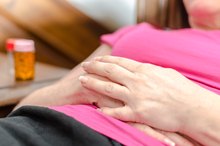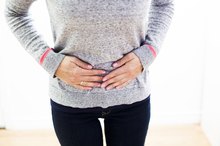What Causes Left Lower Abdominal Pain With Palpation?
Many conditions can cause left lower abdominal pain with palpation 1. According to MayoClinic.com, the abdomen is a common source of pain or discomfort 14. The abdomen is divided into four quadrants. Pain in any one of these quadrants can provide clues to the source of the pain. However, sometimes pain in one abdominal quadrant can cause pain in another quadrant 1. Certain conditions can cause left lower abdominal pain with palpation or pressing in that area 1.
If you are experiencing serious medical symptoms, seek emergency treatment immediately.
Abdominal Trigger Points
According to the American Academy of Family Physicians, an abdominal trigger point is an often-overlooked source of abdominal pain 12. In some cases, with careful palpation or abdominal assessment using the hands or fingertips, a localized trigger point--a hyper-irritable nodule or knot within a tight band of abdominal muscle--can be identified. A trigger point in the abdominal muscles of the lower left abdominal quadrant may cause pain in that area, along with pain that radiates over a diffuse area of the abdomen 1. In the left lower abdomen, trigger points may be found along the lateral or outside margins of the rectus abdominis muscle--one of the principal muscles of the abdomen--or at attachments of muscle and fascia or connective tissue. The AAFP says tender trigger points in the abdomen are usually no larger than 1cm to 2cm in diameter.
Peritonitis
What Causes Abdominal Pain With Palpation?
Learn More
The University of Maryland Medical Center says peritonitis is an inflammation of the peritoneum, a thin membrane that coats the abdominal wall and the abdominal organs 3. Peritonitis is caused by a bacterial or fungal infection. There are two principal types of peritonitis: primary and secondary. Primary peritonitis accounts for fewer than 1 percent of all cases and is caused by an infection that spreads from the blood and lymph nodes to the peritoneum. Secondary peritonitis occurs when the infection spreads from the gastrointestinal tract to the peritoneum.
- The University of Maryland Medical Center says peritonitis is an inflammation of the peritoneum, a thin membrane that coats the abdominal wall and the abdominal organs 3.
- Primary peritonitis accounts for fewer than 1 percent of all cases and is caused by an infection that spreads from the blood and lymph nodes to the peritoneum.
Diverticulitis
According to the National Institute of Diabetes and Digestive and Kidney Diseases or NIDDK, diverticulitis is an inflammation or infection of one or more diverticula--small, bulging pouches that develop anywhere throughout the digestive system 4. Diverticula are often found in the sigmoid colon, in the left lower abdomen. Common signs and symptoms associated with diverticulitis include sudden, severe pain in the left lower abdomen, tenderness with abdominal palpation, changes in bowel habits, fever, nausea, vomiting, constipation or diarrhea 14.cause:
- Common signs
- symptoms associated with diverticulitis include sudden
- severe pain in the left lower abdomen
- tenderness with abdominal palpation
- changes in bowel habits
- fever
- nausea
- vomiting
- constipation or diarrhea 14
MayoClinic.com says the exact cause of diverticulitis is unknown, although certain risk factors may increase the likelihood of developing diverticulitis 14. These include aging, lack of dietary fiber, lack of exercise and obesity. Possible complications associated with diverticulitis include peritonitis, rectal bleeding and blockage of the colon 4.
Related Articles
References
- MayoClinic.com: Abdominal Pain
- American Academy of Family Physicians: The Abdominal Wall
- University of Maryland Medical Center: Peritonitis
- MayoClinic.com: Diverticulitis
- National Institute of Diabetes and Digestive and Kidney Diseases. Symptoms & Causes of Diverticular Disease. May 2016.
- Imaeda H, Hibi T. The burden of diverticular disease and its complications: West versus east. Inflamm Intest Dis. 2018;3(2):61-68. doi:10.1159/000492178
- Onur MR, Akpinar E, Karaosmanoglu AD, Isayev C, Karcaaltincaba M. Diverticulitis: a comprehensive review with usual and unusual complications. Insights Imaging. 2017;8(1):19-27. doi:10.1007/s13244-016-0532-3
- Ansari P. Intra-Abdominal Abscesses. Merck Manual Professional Edition. Updated December 2018.
- Baum JA. Colonic Diverticulitis. Merck Manual Professional Edition. Updated March 2019.
Writer Bio
Martin Hughes is a chiropractic physician, health writer and the co-owner of a website devoted to natural footgear. He writes about health, fitness, diet and lifestyle. Hughes earned his Bachelor of Science in kinesiology at the University of Waterloo and his doctoral degree from Western States Chiropractic College in Portland, Ore.








